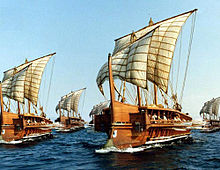
Back Drieriemsgalei Afrikaans ثلاثية المجاديف Arabic Trirreme AST Triyera Azerbaijani Трирема Bashkir Триера Bulgarian Teirroeñveg Breton Trirrem Catalan Triéra Czech Trier (skibstype) Danish

A trireme (/ˈtraɪriːm/ TRY-reem; derived from Latin: trirēmis,[1] "with three banks of oars"; cf. Ancient Greek: triērēs,[2] literally "three-rower") was an ancient vessel and a type of galley that was used by the ancient maritime civilizations of the Mediterranean Sea, especially the Phoenicians, ancient Greeks and Romans.[3][4]
The trireme derives its name from its three rows of oars, manned with one man per oar. The early trireme was a development of the penteconter, an ancient warship with a single row of 25 oars on each side (i.e., a single-banked boat), and of the bireme (Ancient Greek: διήρης, diērēs), a warship with two banks of oars, of Phoenician origin.[5] The word dieres does not appear until the Roman period. According to Morrison and Williams, "It must be assumed the term pentekontor covered the two-level type".[6] As a ship, it was fast and agile and was the dominant warship in the Mediterranean from the 7th to the 4th centuries BC, after which it was largely superseded by the larger quadriremes and quinqueremes. Triremes played a vital role in the Persian Wars, the creation of the Athenian maritime empire and its downfall during the Peloponnesian War.
Medieval and early modern galleys with three files of oarsmen per side are sometimes referred to as triremes.[7]
- ^ from tri- "three" + rēmus "oar".
- ^ from τρι- (tri-) "three" + ἐρέτης "rower"
- ^ Coates, John F. (2000). The Athenian Trireme. New York: Cambridge University Press. pp. 127–230.
- ^ Welsh, Frank (1988). Building the Trireme. London: Constable and Company Limited. ISBN 978-0094668805.
- ^ Casson (1995), pp. 57–58
- ^ Morrison and Williams 1968:155
- ^ See index in Morrison (2004) for examples.
© MMXXIII Rich X Search. We shall prevail. All rights reserved. Rich X Search